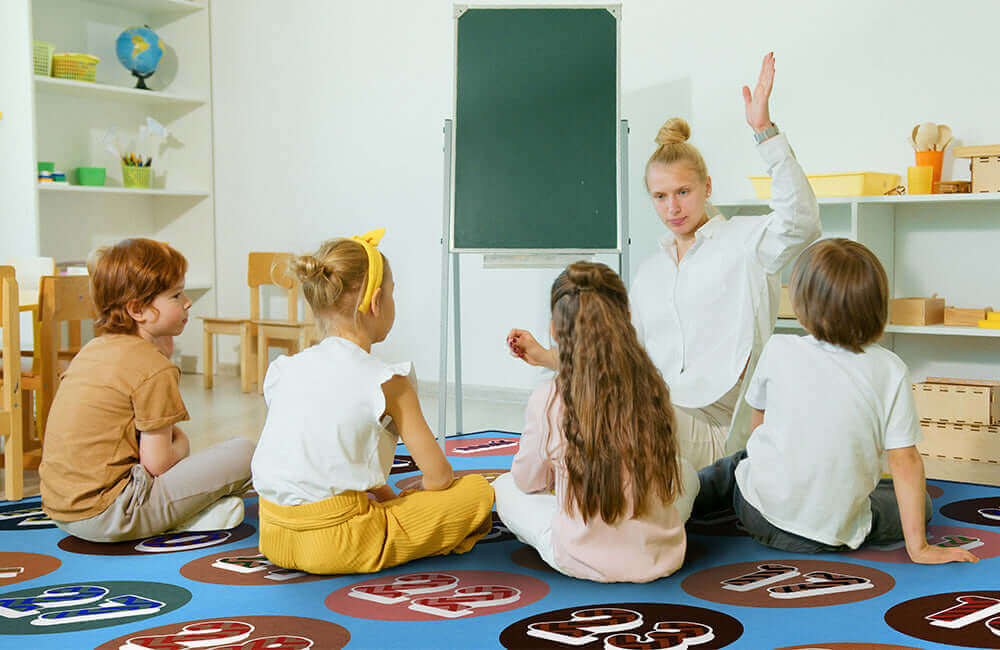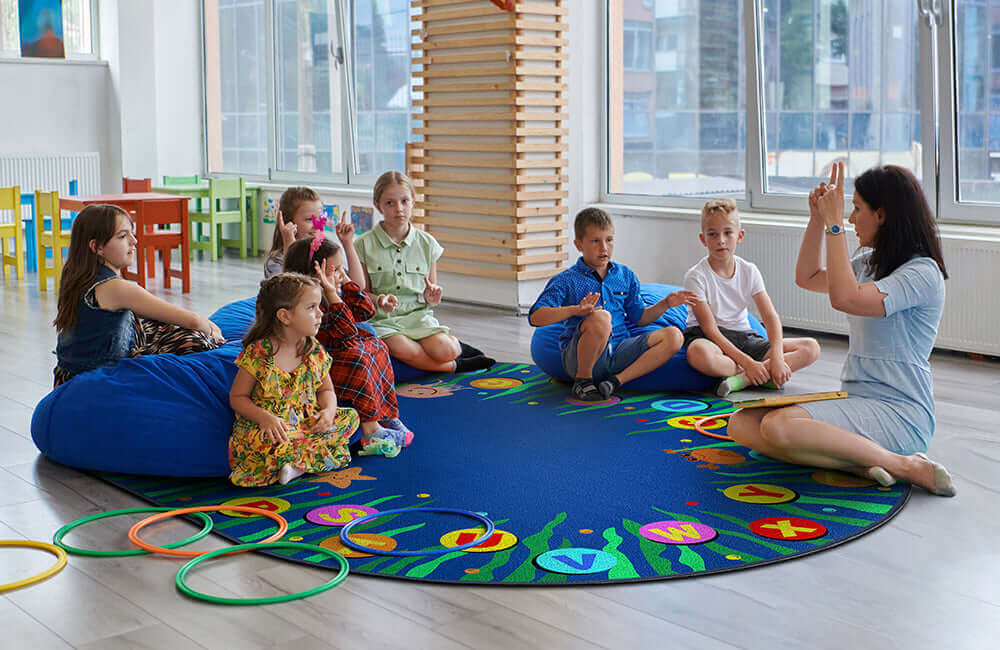The humble classroom rug serves as far more than decorative floor covering—it defines learning spaces, creates comfortable gathering areas, enhances classroom acoustics, and often becomes the heart of many classroom activities. However, selecting a rug with appropriate dimensions can be surprisingly complex, requiring careful consideration of both spatial constraints and educational needs.
The Importance of Proper Rug Sizing
The dimensions of a classroom rug directly impact its functionality and effectiveness. According to Edutopia's classroom design research, "The physical environment sends powerful messages to students about what's expected to happen in a particular space." A properly sized rug creates an inviting area that clearly communicates its purpose.
Key Benefits of Correct Sizing
- Adequate personal space: Proper dimensions ensure each student has enough physical space, reducing discomfort and conflict
- Clear visual boundaries: Well-proportioned rugs create distinct zones within the classroom
- Appropriate activity accommodation: Right-sized rugs support specific learning activities, from whole-class gatherings to small group work
- Room proportion balance: Correctly scaled rugs enhance the overall balance and flow of classroom design
According to classroom design specialists cited in Education Week's classroom environment report, "Properly sized and placed soft furnishings like rugs can reduce ambient noise by up to 30%, creating a calmer learning atmosphere."
Standard Classroom Rug Dimensions
While classroom needs vary, certain standard dimensions have emerged as particularly effective for educational environments.
Early Childhood Classrooms (PreK-K)
- Small group rugs: 6' x 9' accommodates 6-8 young children seated on the floor
- Circle time rugs: 9' round or 9' x 12' rectangular for whole-class gathering with 20-24 children
- Reading nook rugs: 4' x 6' creates a cozy space for 2-3 children
- Play area rugs: 8' x 10' provides defined space for construction or dramatic play
Elementary Classrooms (Grades 1-5)
- Whole-class gathering: 9' x 12' or 12' x 15' rectangular rugs accommodate 25-30 students
- Group work areas: 7' x 10' supports 6-8 students working collaboratively
- Reading corners: 5' x 8' creates space for 4-5 readers
- Teacher-led small groups: 6' x 9' oval or rectangular accommodates teacher and 6-8 students
Middle School Flexible Learning Spaces
- Discussion circles: 10' round or 10' x 10' square for seminar-style discussions
- Collaborative zones: 8' x 10' for small team project work
- Independent work areas: 6' x 6' squares create individual "offices" or reflection spaces
As noted on Wikipedia's educational environment page, "The physical arrangement of classroom spaces, including soft furnishings like rugs, significantly impacts student engagement, behavior, and learning outcomes."
Sizing for Different Learning Activities
Different educational activities require specific dimensions for optimal function. Consider these activity-based sizing guidelines:
Whole-Class Gathering
The most common use for classroom rugs is whole-group instruction or morning meetings. For this purpose:
- Standard classrooms (25 students): Minimum 9' x 12'
- Larger classes (30+ students): 12' x 15' or 12' x 18'
- Space calculation: Allow approximately 2-2.5 square feet per student when seated on the floor
Cult of Pedagogy's classroom layout article emphasizes that "adequate personal space during floor seating is essential for student focus and community building."
Small Group Instruction
For teacher-led small groups:
- 4-6 students plus teacher: 6' x 9' rectangular or 8' round
- Guided reading groups: 7' x 7' accommodates a small table and chairs plus floor space
- Math or manipulative groups: 8' x 8' allows space for materials and movement
Centers or Stations
For dedicated learning centers:
- Literacy centers: 6' x 6' minimum for 3-4 students with materials
- STEM exploration spaces: 7' x 8' allows for materials and active engagement
- Art centers: 8' x 8' or larger to accommodate supplies and projects
Reading Areas
For dedicated reading spaces:
- Individual reading nooks: 4' x 6' creates space for 1-2 readers with pillows
- Small library areas: 8' x 10' accommodates shelving, seating, and movement
- Book discussion spaces: 7' x 7' round creates an intimate conversation area
Space Planning Considerations
Selecting the right rug dimensions requires careful consideration of your specific classroom configuration.
Measuring Your Space
Before purchasing, follow these steps:
- Map existing furniture: Create a basic floor plan showing fixed and essential furniture
- Identify traffic patterns: Mark primary pathways that should remain clear
- Measure available areas: Calculate dimensions of potential rug locations
- Account for clearance: Allow 18-24" between rug edges and surrounding furniture
- Consider door swing: Ensure rugs don't obstruct door movement
Room Proportion Guidelines
For balanced room design:
- Small classrooms (600-800 sq ft): Rug should cover 20-25% of open floor space
- Medium classrooms (800-1000 sq ft): Rug can cover 25-30% of open floor area
- Large classrooms (1000+ sq ft): Consider multiple rugs for different zones rather than one oversized rug
Multi-Rug Strategies
Many classrooms benefit from multiple rugs rather than one large one:
- Zone definition: Use different rugs to clearly delineate learning areas
- Flexible regrouping: Smaller rugs can be repositioned as needed
- Varied activities: Different sized rugs can support simultaneous activities
According to Learning Spaces Magazine, "Using multiple rugs of appropriate dimensions rather than a single large carpet creates more adaptable learning environments that support diverse teaching approaches."
Shape Selection for Learning Spaces
The shape of a classroom rug affects both its functional dimensions and how students interact within the space.
Rectangular Rugs
The most common shape offers several advantages:
- Efficient seating arrangement: Accommodates rows or circles effectively
- Clear boundaries: Defines space with obvious edges
- Furniture alignment: Coordinates well with typical classroom furniture
- Recommended dimensions: 9' x 12' is the most versatile size for most classrooms
Round Rugs
Circular rugs create different dynamics:
- Equal focus: No "front" or "back" of the learning space
- Collaborative atmosphere: Encourages face-to-face interaction
- Space efficiency: 9' diameter seats approximately 20 K-2 students
- Visual interest: Creates a focal point in the classroom
Oval Rugs
Combines benefits of both rectangular and round:
- Direction with equality: Provides some orientation while minimizing corners
- Space adaptation: Often fits room configurations better than perfect circles
- Recommended dimensions: 7' x 9' oval works well for guided reading groups
Specialized Shapes
Some classrooms benefit from:
- Kidney-shaped rugs: 9' x 12' creates natural teacher position at the curve
- Hexagonal rugs: 8' across supports small group activities with defined positions
- Interlocking shapes: Multiple smaller rugs that can be reconfigured
Positioning for Classroom Management
The placement of a rug affects not just its fit but its function within classroom management systems.
Strategic Placement
Consider these positioning principles:
- Visibility: Place whole-group rugs where all students can see instructional areas
- Accessibility: Ensure clear paths to and from the rug
- Separation: Position rug areas away from high-distraction zones
- Intentionality: Align rug placement with your classroom management philosophy
Teacher Position Considerations
The teacher's position relative to the rug affects interaction:
- Edge positioning: Teacher at rug edge with students on the rug works for direct instruction
- On-rug positioning: Teacher seated on the rug creates more collaborative atmosphere
- Adjacent positioning: Teacher at nearby desk/table works for independent rug activities
According to TeachThought's classroom design blog, "The arrangement of student gathering spaces, including rug areas, should intentionally support the primary modes of instruction used in the classroom."
Material Considerations for Longevity
When investing in classroom rugs, material quality directly affects durability and performance.
Recommended Materials
For educational settings, these materials offer the best balance of durability and function:
- Nylon commercial grade: Highest durability for high-traffic classrooms
- Olefin/polypropylene: Good stain resistance and moderate durability
- Wool blends: Natural option with excellent durability but higher cost
- Solution-dyed fibers: Maintains color even with cleaning and sun exposure
Backing Types
The rug backing affects safety and longevity:
- Rubber non-slip backing: Essential for safety in early childhood settings
- ActionBac™: Woven synthetic backing that maintains shape
- Attached rug pads: Provides cushioning and stability
Pile Height
The thickness of the rug affects both comfort and function:
- Low pile (¼"): Easiest for student movement and furniture placement
- Medium pile (½"): Balances comfort and practicality
- High pile (¾"+): Provides comfort but may impede mobility and collect more debris
Budget-Friendly Options
Quality classroom rugs represent a significant investment, but several strategies can help manage costs.
Alternative Rug Sources
Consider these options for reducing expenses:
- Educational surplus outlets: Often sell used but serviceable classroom rugs
- Remnant carpet squares: Can be bound to create custom-sized rugs
- Modular carpet tile systems: Allow for replacement of damaged sections rather than entire rug
- Commercial office liquidations: Office-grade carpets often work well in classroom settings
DIY Options
For extremely limited budgets:
- Bound carpet remnants: Carpet stores can bind edges of remnants for durable classroom rugs
- Painted floor canvas: Heavy-duty canvas with painted educational elements and sealed edges
- Interlocking foam tiles: Creates removable, washable gathering spaces
According to Classroom Q&A on Education Week, "While dedicated educational rugs are ideal, creative alternatives can effectively define learning spaces when budgets are constrained."
Conclusion
Selecting the right classroom rug dimensions involves balancing spatial constraints, pedagogical needs, and practical considerations. By understanding the relationship between rug size, classroom activities, and student engagement, educators can make thoughtful choices that enhance learning environments.
Remember that the ideal rug dimensions for your classroom should reflect your specific teaching style and student needs. Whether you opt for a large gathering rug, multiple activity-specific rugs, or creative alternatives, the goal remains the same: to create comfortable, functional spaces that support learning.
For more information on creating effective learning environments, explore our related articles:









Leave a comment
This site is protected by hCaptcha and the hCaptcha Privacy Policy and Terms of Service apply.